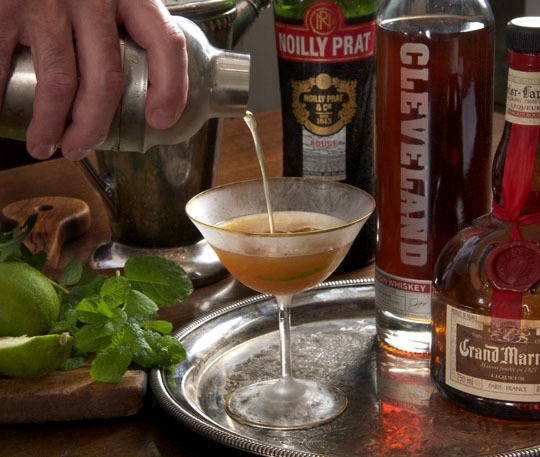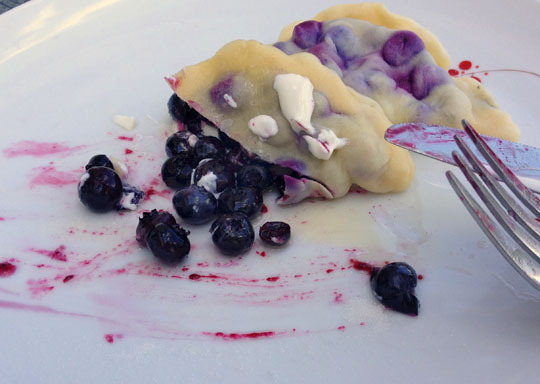Michael Ruhlman's Blog, page 35
October 9, 2013
Chicken-Tagine-Recipe Recipe
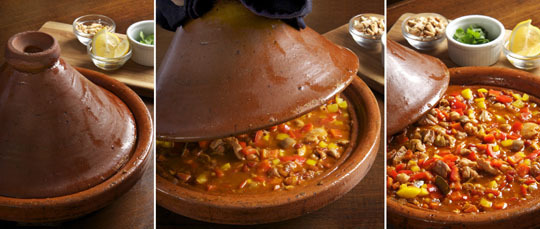
The tagine is a great stovetop cooking vessel. Photo by Donna Turner Ruhlman.
I was so delighted by the Kate Christensen recipe I’m making a version of it here that reflects my way of cooking. Is it a repeat? That’s part of the point—the best dishes in your repertoire are ones you do over and over. Indeed, Christensen wrote about it in a novel, and then wrote about it again in a memoir, and has made it for real herself, so it obviously bears repeating. As do all good recipes. And this one is not only supremely tasty and therefore a pleasure to eat, it’s also deeply nourishing, especially if you use your own stock.
I was also intrigued by a few commenters who did not like the narrative recipe, a recipe without ingredient list and numbered steps, but with writerly flourishes—”fragrant brown spice puddle”—which of course I love.
So, here is my version cooked in a proper tagine, which my dear old mum haggled down from a buck-fifty to fifty cents at a bazaar in 1970s Morocco. It’s a great cooking vessel, especially an earthenware one with an unglazed interior that absorbs moisture and aromas. The clay vessel sits right on your stovetop burner looking in today’s kitchen like a proud, exotic peasant. (Of course a small dutch oven or any medium sauce pan with a lid will do.)
Here, everything gets cooked together in the same pot, so you don’t have to wash two. To imitate ghee, I melt the butter and just use the butter fat (save leftover whey and solids and butter fat for browned-butter mashed potatoes). I use salt, especially at the beginning. Chicken thighs are tough, succulent morsels and chix breasts are the skim milk of the protein world, to be avoided unless pounded, breaded, and fried, so please squelch any impulse to add anything other than thigh meat.
Kate specifies cracked olives, Turkish apricots and a brand-name Italian tomatoes, all well and good (indeed specificity describes interesting idiosyncrasies), but I hope it’s needless to say that any tasty olive will do, as will any dried apricots if you can’t find Turkish ones, as will any tomato “product,” as it was unimaginatively referred to in culinary school, fresh or canned or boxed. But what makes this recipe so wonderful and, to use the word again, beguiling, is the aggressive seasoning and splendid use of flavoring ingredients (salty olives and sweet apricots and crunchy nutty toasted almonds), which are all Kate’s, thus named here and written in format.
Kate’s Chicken Tagine
1/2 stick of butter, completely melted in a measuring cup
4 boneless, skinless chicken thighs, cut into about 6 pieces each
Salt as needed
1 medium Spanish onion, medium dice
5 cloves garlic, smashed with a knife and roughly chopped
1 tablespoon grated ginger
2 teaspoons ground coriander
2 teaspoons cumin
½ teaspoon cayenne
¼ teaspoon cinnamon
1 bay leaf
Zest from half a lemon
½ cup chopped olives
½ cups chopped dried apricots
1 carrot, medium dice
one 15-ounce can chickpeas (about 1 1/2 cups if you cook your own)
1 cup diced tomatoes (fresh or canned)
1 cup homemade stock or water (or more as needed, depending how long you cook it)
½ red pepper, medium dice
½ yellow pepper, medium dice
½ cup slivered almonds, toasted
Enough cilantro for garnishing and flavor (for those not averse)
4 lemon wedges
Put the tagine over a low flame, then turn it up to medium-high. Pour in enough clear butter fat floating on top to coat the bottom of the tagine, and turn the flame to high. Add the chicken and cook till browned (they need not be cooked through). Remove the chicken to a bowl.
Add a little more butter to the tagine if necessary, and add the onion, garlic, and ginger. Reduce the flame to medium. Give them two four-finger pinches of salt, and stir to cook until tender. Push them aside and add the coriander, cumin, cayenne, and cinnamon to the tagine and stir to cook them, then stir everything together, adding the bay leaf and lemon zest, and cook it till the onion is completely tender, about 15 minutes (careful not to let anything burn). Lower the heat if it’s burning.
Add the olives, apricots, carrot, chickpeas, tomatoes, stock or water, and the cooked chicken, and bring it to a simmer, stirring, then cover the tagine and simmer on low for 1 to 4 hours (the longer the better). Add the peppers just before stirring, giving them enough time in the stew to soften, 5 minutes or so.
Serve with couscous or basmati rice and garnish with the almonds, cilantro, and a wedge of lemon.
Serves 4
If you liked this post, take a look at these links:
My recent post on Bacteria! Run Away! Run Away!
David Lebovitz’s recipe for lamb tagine.
Video: watch how the tagine vessel is made with clay on the wheel.
A refreshing drink at the end of dinner is a cup of Moroccan Mint Tea.
© 2013 Michael Ruhlman. Photo © 2013 Donna Turner Ruhlman. All rights reserved.
October 7, 2013
Blue Plate Special: Chicken Tagine

Blue Plate Special, a writer’s memoir.
Kate Christensen is exactly the kind of woman I would spend all my time trying to bed if I weren’t already married to The Most Wonderful Woman in the World. She’s hot, with the most beguiling eyes, and expressions, I’ve encountered (we once shared a stage at the Key West Literary Seminar); she’s smart as lightening, and she writes fabulous books. Readers of this site, if you haven’t read Epicure’s Lament, put it next on your list, followed by The Great Man, which inspired the below recipe. That’s right: a fictional scene generated this most delicious North African–style chicken stew, a version of which I made for Donna on Saturday. It’s also a lesson in the way recipes ought to be written and followed.
Christensen’s most recent book, a memoir, Blue Plate Special, began as a series of blog posts after which the author got carried away (the best of reasons to do anything). It’s the story of her life, with food bits tacked on here and there, and while it’s true she loves to cook and to eat, Blue Plate Special is really the story of a girl, born in 1962 to West Coast hippie intellectuals (and not happy ones at that—the violence of her father, and the resulting complex love-hate-fear theme runs throughout), who makes her bumbling way through life just as we all do—childhood dangers skirted, sometimes barely, early struggles through college and miserable jobs, marriage, affairs, travel, writing.
Life is fraught, often joyful, often terrible, and it certainly does not arrive in the neat package of a cohesive narrative. That is the artist’s job, to order the chaos, with hopes of finding at least some understanding in what, without art, without narrative, would be unendurable meaninglessness. Christensen is just such a soul, as exemplified by the writing and storytelling in this excellent memoir, in which the following recipe appears.
Chicken Tagine
I invented this recipe by describing it on the fly in the first chapter of my novel, The Great Man, in which a seventy-four-year-old woman half seduces a forty-year-old man with food, and then I made it in order to test my imaginative culinary instincts. There is no modest way to say this: the apricots melt into the broth and sweeten it deeply, the olives give it brine, and the almonds and cilantro and lemon bring it to life. And it contains cinnamon; it is, in a word, delicious.
On low heat, sauté a chopped red onion and 5–6 minced garlic cloves in lots of butter (or ghee) or oil. Add coriander and cumin, about a tablespoon—yes, I said tablespoon, of each (feel free to use already ground; I like using a mortar and pestle, but some people don’t)—a teaspoon of cinnamon, half a lemon’s worth of grated zest, a generous pinch each of saffron and cayenne, a teaspoon of paprika, 2 bay leaves, and a thumb-sized lump of grated fresh ginger. Keep heat low, stir constantly, and make sure nothing burns or sticks; add more ghee or oil if necessary.
When it’s all cooked into a commingled fragrant brown spice puddle, add a red and a yellow pepper, diced; a large carrot or 2 medium carrots, peeled and chopped small; a generous handful of cracked green olives; a handful of dried Turkish apricots, chopped small; one 15–16 ounce can of well-rinsed chickpeas; a cup of Pomì diced tomatoes; and a cup of hearty chicken broth. Bring to a gentle boil, then right down to a simmer, and cover.
Cut up 5 skinless, boneless chicken thighs and 3 breasts, more than 2 pounds of chicken in all, into big bite-size pieces—the kind you have to cut in half to really eat—and grill them in a cast-iron skillet in ghee or oil till they’re brown just on the outside and still raw inside, then add them to the stew and stir everything together and gently simmer it, covered, for 4 1/2 hours. Add more chicken broth as necessary.
Sauté and slightly brown 1 package or 2 cups couscous—or, if you’re gluten intolerant, quinoa—in 2 tablespoons butter, then cook according to the directions on the packet. Serve with harissa or shug, along with bowls of chopped toasted almonds, lemon slices, and chopped fresh cilantro.
Thanks, Kate, keep on writing and cooking!
If you liked this post, take a look at these links:
My recent posts on NYC and Seeds.
Forrest Pritchard’s guest post on his memoir of becoming a farmer Gaining Ground.
Learn more about the history of the tagine.
Here are some other Moroccan dishes for you to try out.
© 2013 Michael Ruhlman. Photo © 2013 Donna Turner Ruhlman. All rights reserved.
October 4, 2013
Friday Cocktail Hour: The Derby
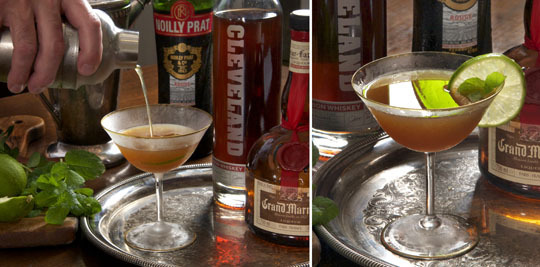
Derby cocktail. Photo by Donna Turner Ruhlman.
When I opened to the Cleveland Plain Dealer‘s wonderful and expanded food section, I was delighted to find a handful of bartenders offering cocktails. The Derby, offered by Lindsey Hawes, who mixes drinks at The Willeyville in the Cleveland Flats, caught my eye (here she is making another fave of mine, The Dark & Stormy). The Derby caught my eye for its straightforwardness and lack of frou. I immediately thought of the Brown Derby, a restaurant chain that flourished here in the 1970s, where I first encountered what was called a salad bar, back in the pre-sneeze guard days (God, how I long for the simpler times when people didn’t freak out about bacteria and rub sanitizing gel on their hands every five minutes). Potatoes came foil wrapped (an actual botulism worry, in fact). Butter was all but frozen in foil packets, and the onion rings adorning the filet mignons came out of a plastic bag. How I loved going to the Brown Derby with my mom and dad, Uncle Jon, and Aunt Barb.
I don’t know the provenance of this cocktail, though Leite’s Culinaria traces it to the 1940s and Trader Vic. But I love it for its bourbon wallop, the sweet vermouth, orange liqueur, and sharp lime juice, with a light aromatic mintiness lingering on the tongue.
Mint can be used in the garnish only or muddled delicately in the shaker (but not pulverized—no shreds of leaf should be in the pour). A lovely fall cocktail as the evenings grow cooler.
I used a new bourbon I’d been meaning to try, shipped in to Cleveland and then rapidly aged using a new speed-aging technique. It’s not Blanton’s or Woodford, but it’s pretty damn good and perfect for this cocktail.
The Derby
2 ounces bourbon
1 ounce sweet vermouth
1 ounce Grand Marnier
3/4 ounce fresh lime juice
1 lime disk, for garnish (optional)
1 mint leaf, for garnish (optional)
Fill a cocktail shaker with the bourbon, sweet vermouth, Grand Marnier, and lime juice. Muddle some mint in it gently if you wish. Add ice and stir for 90 seconds or so.
Strain the concoction into a chilled coupe. Garnish with the lime wedge and mint leaf.
Other links you may like:
Other cocktails featuring bourbon: the classic Manhattan, the Mint Julep, and the Boulevardier.
Headed South? Then visit the bourbon trail in Kentucky.
Food & Wine shares a list of various bourbon-based cocktails.
What makes a bourbon bourbon?
© 2013 Michael Ruhlman. Photo © 2013 Donna Turner Ruhlman. All rights reserved.
October 2, 2013
Letter from NYC, Part Two: Seeds
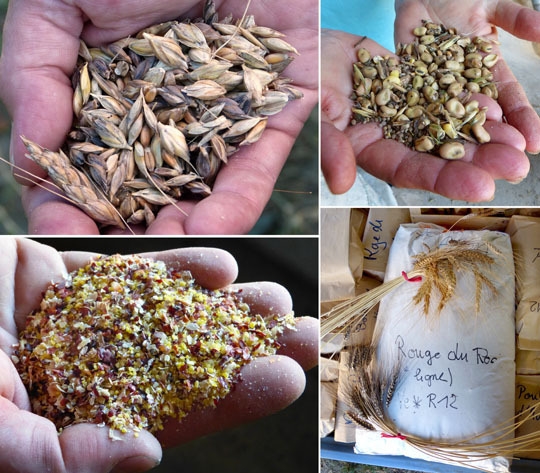
A handful of grain. Photos by Donna Turner Ruhlman.
I got so carried away with my enthusiasm for Omar’s I didn’t get to the rest of my NYC post, which needs to emphasize an important event, orchestrated by Ferran Adrià, that took place in Manhattan and at Blue Hill at Stone Barns.
(A number of people asked what show my Mom took me to before that lovely dinner. It was The Trip to Bountiful, for which Cicely Tyson won a Tony. I mention it not because it’s a lovely, subtle play [and movie with ] by Horton Foote, but because it was such an unexpected thrill to see genuine star power on stage. And I’m not talking about the power of celebrity, which is its own weird, slightly creepy entity, but rather power that comes from within, the diamond-hard center of an artist. Tyson lights up the stage with her enormous talent. Moving beyond words. Had this been the 1950s, I’d have sent a bouquet to her backstage and begged to introduce myself.)
But before the show, I was lucky enough to spend an hour with Ruth Reichl in the lovely library section of the bar at the NoMad Hotel. Ruth had just been to the aforementioned event at Stone Barns and had been deeply impressed. It merited the attention of the NYTimes the following day, and here’s why it was so important to Ruth, what made it a powerful event:
Dan was focused on having the chefs work with the breeders, she wrote in a follow-up email, so they can, as he says, “write the recipe from the very beginning.” And that’s certainly a compelling idea. The next day Michael White said to me, “I’d never thought about the fact that we were working with compromised ingredients.” But the three facts that really stuck with me had nothing to do with that.
1. We’re telling people to eat more vegetables, and many of the vegetables that they’re eating don’t have much nutrition.
2. Seminis, the largest seed company in the world (owned by Monsanto), controls 40% of tomato genetics.
3. If you could go back a hundred years and ask a seed breeder about some “heirloom” variety, he’d look at you as if you were insane and ask why you were focused on a hundred-year-old variety. For breeders it’s a constant process of evolution. I think about that now, every time I see an “heirloom” tomato.
Dan Barber wrote in an email what he thought most important: “That heirloom and heritage breeds, while great, are the past—they represent a moment in time that we stopped and captured. Modern breeders can do a lot better—better nutrition, better yield, and better flavor. They simply need to be asked. Right now, no one is asking them.”
And everyone seemed to agree that as multinational corporations control more seed genetics and promote monocultures (bad to rely on as they can be decimated by bacterium, like this corn), it is critical for chefs and consumers to encourage breeders to create seeds that give us exactly what Barber and Reichl asked for—most of all, better nutrition.
It’s an idea I encountered when I wrote about one of the great food areas on the planet, Gascony, the southwest corner of France, where I met a “peasant baker” who is growing small patches of 250 different kinds of grain (shown above) to sell to growers, and where the wonderful Kate Hill of Kitchen at Camont, while driving Donna and me to the Chapolard farm, which grows the feed for its own hogs, said to us, “When you barbecue ribs, does it start with the pig? No, it starts with the seeds.” In the upper right photo Kate holds the feed grown by the Chapolard family.
It should be obvious but it’s not: we need to focus on where our food (all life, for that matter) begins: the seed.
© 2013 Michael Ruhlman. Photo © 2013 Donna Turner Ruhlman. All rights reserved.
September 30, 2013
Letter From New York: The Restaurant Omar

Hamachi and horseradish by Julian Proujansky at Omar in NYC
Here’s how it happened. When my mom asked me what she could give me for my 50th birthday, I said “A Broadway show and a nice meal, just the two of us.” The restaurant she chose was one of her faves, Marea, but then she changed her mind—her pal Cynthia, with whom she was staying on the UN-traffic-clogged East Side, said we had, had, had to go Omar’s—only open ten weeks. I hadn’t heard of it. Checked it out on Urban Daddy—interesting but I hate clubs. I looked into the namesake and thought, South American party boy—I don’t know, Ma. But she’d reserved it, even ordered a car for after the theater for the special occasion, so I didn’t argue.
It’s in one of my favorite neighborhoods, West 9th between Fifth and Sixth and we descended from the sidewalk to a lovely long bar and main room, casual, and leading off to the left, the more clubby, sleek black club part of the restaurant. Service was attentive and Omar himself brought us back. All were friendly (they knew my work). I had a bit of stomach bug and didn’t really care about eating, really just wanted to be with Mom. I ordered gougeres to soothe my irascible tummy, and the hamachi for Mom who was unfamiliar with it, and we proceeded to gab.
And then the above hamachi came out and I tasted it. It was joltingly good. What? I wasn’t expecting this. Horseradish. Hamachi and horseradish? So utterly simple, so surprisingly good. Such an imaginative pairing.
“Excuse me,” I asked Caroline, one of the attendants floating gracefully around us. “Who’s the chef?” None of the press seemed to have mentioned who it was.
“Julian Proujansky.”
“I don’t know him. Where is he from?”
“He was at Eleven Madison Park.”
Ahhh, I thought. OK, the hamachi was not a fluke. (Sorry.) Here is a bar, restaurant, and dining club that will have some serious culinary chops and I hope those running the place will take very good care of the kitchen staff, led by the affable Julian, and his chef de cuisine Morgan Schofield. They were always bouncing ideas off each other, Julian said, so it’s clear I must credit both for the ingenious simplicity of fresh grated horseradish on hamachi (with peaches marinated in white balsamic, olive oil and salt to finish it off).
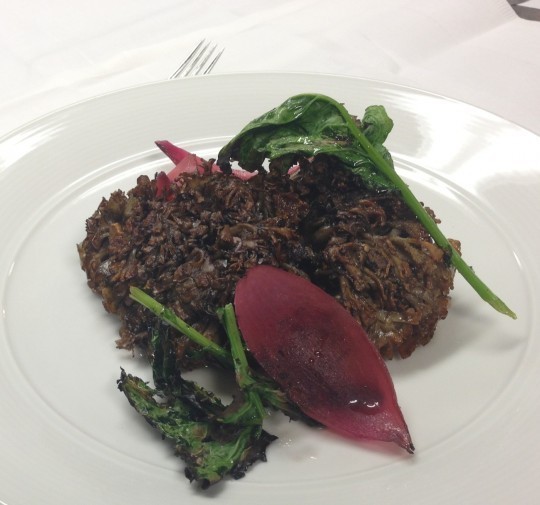
Hen of the woods mushrooms with grilled broccoli rabe.
They had recieved immaculate hen of the woods mushrooms and rightly featured them as a kind of “steak.” And we were offered the first white truffles of the season they’d received ($85 surcharge Caroline noted; thank you, I hate having to ask) and as it was my b-day night with Ma, and Ma was picking up the ticket, absolutely! Rain white truffle! Perfect on perfect, pillowy light gnocchi.
So here’s what I loved: the incredibly simple gougeres were lovely; if you can’t do simple perfectly, you’re in trouble. I already mentioned the horseradish (“there is genius in simplicity”). The mushrooms: the kitchen featured what was special about them, the meaty texture and earthy flavor; the dish wasn’t much to look at, as you can see, but in this case looks were beside the point because they were so good; the kitchen had put its work into the service of the mushrooms, roasting them with butter and thyme, bay and garlic. And last, gnocchi, which aren’t so simple, often they are dough-ball sinkers (the key is to cut the dough as for biscuits to avoid overworking the flour, Chef explained). These were light and flavorful. And well, white truffle is white truffle, one of those gift-of-god foods that I will never turn down.
People often ask me if I ever think of opening my own restaurant, to which I always reply, “Are you fucking kidding me?” And so it is always with best wishes and admiration that I approach any new restaurant, no matter what kind and no matter its ambitions.
So it is with special high hopes that the very charming and genuine Omar Hernandez and those financing this auspicious new venture give this talented kitchen free reign.
Related links:
My Upcoming Events.
Check out these places in NYC: Ippudo NY, Milk Bar, and Shake Shack.
The Culinary Librarian, a lovely blog written by Mary Rosch.
Looking for a cocktail in the city go to The Dead Rabbit Grocery and Grog.
© 2013 Michael Ruhlman. Photo © 2013 Donna Turner Ruhlman. All rights reserved.
September 27, 2013
Friday Cocktail Hour: The Cobbler
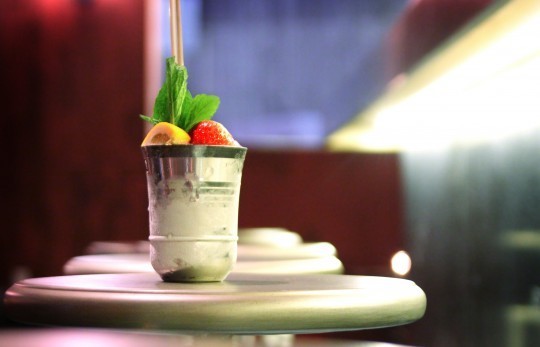
The sherry cobbler from Bellocq.
Today’s cocktail is a new one for me, via Emilia via Pableaux (see below). It’s a sherry and fruit cocktail from the early 19th century called a Cobbler. A Google search will give you all sorts of spirit-based “cobblers,” but how they differ from a basic whiskey cocktail is, well, they don’t. So let’s keep the term clean! A cobbler is a sherry-based cocktail! And truly refreshing!—M.R.
Friday Cocktail Hour is probably one of my favorite weekly segments I have been part of since I began working with Michael and Donna. Every week I get to learn a new classic cocktail or an interesting variation. Since living in Chicago I have been blessed with not only a fantastic food scene, but also a thriving mixology scene. I’m constantly tempted to have multiple “happy hours” at places such as Sable, The Office, Aviary, The Violet Hour, Longman & Eagle, and Maude’s Liquor Bar. So much temptation.
A few months back I connected with a couple of high school friends, one of whom is getting married next month. I took the ladies for a fantastic cocktail night at Grant Achatz’s Office. They loved it. Not more then a month later I was invited to my friend’s bachelorette party, which was going to be held in New Orleans. I had never been to NOLA, but I knew Tales of the Cocktail is held there every year and the food scene is out of this world. Luckily Jennifer, the bride to be, is a foodie and loves having a good time.
I touched down in NOLA only to see that Michael had emailed his friend Pableaux Johnson who lives in the city to help me out. My phone began to jingle and there was Pableaux, my on-call “adventure in the city” contact. Pableaux also made a great app called Eating New Orleans that is an interactive guide to the food culture, cocktail life, and dining opportunities in New Orleans.
Pableaux assured me of one thing: the Hotel Modern, where the bachelorette party is calling home base, has two fantastic bars (Tivoli & Lee and Bellocq). Which is totally true! New Orleans is home to many cocktails the Sazerac, the Hurricane, Ramos Fizz, and Vieux Carré; but there is a wealth of other high-quality handcrafted cocktails hidden in this amazing city. Go out and find them; and yes you can order them in a to-go cup.

The girls: Lisa, Emilia, Kim, and Jennifer (the bride to be).
My first text from Pableaux: “Go to happy hour at Bellocq and have a cobbler.” Hmmm, a cobbler? Why the hell would I have a fruit cobbler for happy hour? I strolled down to the bar to look at the menu and saw “The Cobbler.” Aha! It’s a drink.
The cobbler is a simple sherry-based (or fortified wine–based) drink. It had its heyday in the 1830s to late 1800s; recipes appeared earlier and references are abound in literature. It’s beauty is in its appearance. The recipes are many and varied but the method is usually a good pour of a sherry, some sugar, and a few pieces of fresh fruit. And lots of small pieces of ice. Then an artful eye to decorate it with fruit and herbs. Don’t forget to add that straw.
I loved that the Bellocq served the cobbler in a tin cup, a very southern thing (e.g., mint julep‘s traditional vessel). The cobbler is a fun and different cocktail, and can wow a guest with its beautiful presentation. With fall quickly approaching I think it is about time for you to whip up a cobbler or two, pop in a straw, and enjoy the last few weeks of summer.
Cheers to both new and old friends!
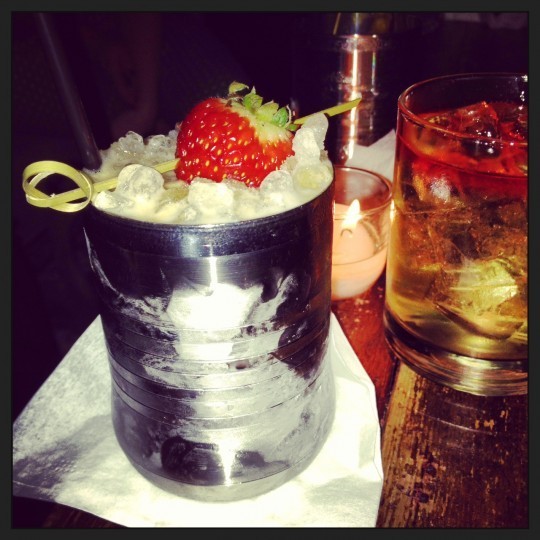
Various cobblers from Bellocq.
Sherry Cobbler
3 ounces amontillado sherry
1 teaspoon superfine sugar (or table sugar if you don’t have superfine)
3 quarter wheels* of orange
3 quarter wheels* of lemon
Fresh berries for garnish
1 straw
Combine the sherry, sugar, and 2 quarter wheels each of the orange and lemon in a shaker with ice and shake briskly. Strain into a julep or delmonico glass filled with small pellets of ice (some recipes call for simply pouring out the contents unstrained into the cup).
Decorate with the fresh fruit with an artful eye. Consume via straw.
* (that’s three 1/4 of a wheel pieces )
Other links you may like:
Other interesting cocktails: the Ludwig, the , and Scamper Juice.
Great places to visit in New Orleans: Cochon, Carousel Bar, Cochon Butcher, Antoine’s, Cure, and Pêche.
Learn more about the cobbler.
Sherry is a fortified wine made with white grapes. Find out how it is made.
© 2013 Michael Ruhlman. Photo © 2013 Donna Turner Ruhlman. All rights reserved.
September 26, 2013
Upcoming Events

Fresh carrots. Photo by Donna Turner Ruhlman.
I am loving being in NYC in this glorious fall weather, but work (and the city’s nefarious distractions) keep me from posting. After three wonderful, indeed humbling, events in Chicago and Milwaukee to promote the new book, The Book of Schmaltz, and the new and updated version of Charcuterie, I’m no longer dreading the many events scheduled for fall. I’ll be back next week with a proper post on NYC (and a fab new restaurant I lucked into), but in the meantime, here’s a list of where and when I’ll be this fall, often with that charcuterie maestro, chef Brian Polcyn.
Full Events List on Facebook (or scroll down to see more detailed info). Hope to see as many of you as possible. Happy cooking!
In Cleveland, yay!
Appearing at Le Creuset Signature Store, Legacy Village
Wednesday, October 2
6:30pm
Le Creuset Signature Store in Legacy Village; Lyndhurst, Ohio
Talk on his latest book, “The Book of Schmaltz: Love Song to a Forgotten Fat”
Space is limited, reservations are suggested, please call 216-291-8795
A Night with Michael Ruhlman: Featuring The Book of Schmaltz
Wednesday, October 9
6:00pm-8:00pm
The Seasoned Farmhouse Columbus, Ohio
Is delighted to present an event with James Beard award-winning author Michael Ruhlman, who will be lecturing on his culinary pursuits and his newest book, The Book of Schmaltz: Love Song to a Forgotten Fat. You will also get to enjoy recipes from The Book of Schmaltz cooked by Chef Bill Fugitt from White Rabbit and will receive a signed copy of the book with your registration.
$75, demo class
An Evening with Ina Garten
Thursday, October 17
7:30pm
Benedum Center Pittsburgh, Pennsylvania
Nose to Tail Workshop
Friday, October 18 to Saturday, October 19
Deer Isle, Maine
Island Culinary & Ecological Center
http://www.edibleisland.org/
Pigstock TC
Monday October 21 to Wednesday, October 23
Traverse City, Michigan
http://pigstocktc.com/
To see the November and other future events, please visit my Facebook page.
September 23, 2013
Stephanie’s Pasta Primer
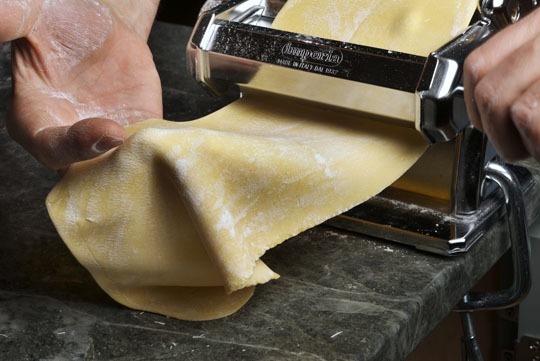
Rolling out homemade pasta dough (because I love the photo; the post is about store-bought dried, what we most often use). Photo by Donna Turner Ruhlman.
Stephanie Stiavetti (@sstiavetti) writes The Culinary Life blog. Her first book, Melt: The Art of Macaroni and Cheese , will be available October 22 from Little, Brown, and it’s superb, the best one I’ve seen, in fact—accept no imitations!
Her last guest post was something of a rant, which I’m always in favor of! This is a lovely primer on something we do often but tend to ignore the finer points of, boiling pasta, and to me, the finer points are what make cooking fun Take it away, Steph! —M.R.
A few weeks ago I talked about the demerits of cheap pasta and left you with the notion that artisan-made dry pasta is leagues ahead of its tasteless, texture-less, mass-produced cousins. It’s also worth noting that cooking dry pasta is an art in and of itself; while it’s a simple process, there’s still a high margin of error.
Since I just wrote a whole damn book on cooking with pasta I thought it might be useful to spell out the best way to prepare dry pasta, so even if you’re cooking with the cheap stuff you’ll have the best possible eating experience. I still argue that the best pasta is that which you make yourself, and we should be covering that in the upcoming weeks. For now, here’s a few tips to get the most out of dried pasta. Pop quiz: How long has that box of noodles been sitting in your cupboard, anyway?
Step 1: Boil some water.
This might seem like a no-brainer, but a lot of people get tripped up on this step and it’s downhill from there. You want the pot of water to be large enough that the noodles can float and bob freely, bumping into each other as infrequently as possible to prevent sticking and clumping. If you cook your pasta in too little water, the noodles will stick together into a gummy, half-cooked mess. The minimum amount of water you want to boil your pasta in is one quart, and that’s the amount you’ll need for just two servings of noodles. Large quantities of pasta will require an even bigger pot. Don’t be afraid to bust out the stockpot if you’re feeding a large group.
–>The standard water : pasta ratio: 1 quart of water for every 1/4 pound (4 ounces) of pasta.
Step 1.5: DO NOT add oil to the water.
Half of my family adds oil to their cooking water because they believe it prevents the noodles from sticking together, but it’s just not true. When you add oil to water, it floats on the surface. That’s it. Any oil that does grab the pasta will do nothing but slick it up. You actually want some sticky starch on the surface of your pasta so that sauce clings to the noodles.
Step 2: Salt the water.
Salt is very important when preparing pasta. It does a lot to bring out the flavor in both the noodles and your overall dish. After you’ve tasted pasta cooked in well-salted water, noodles cooked in plain water will taste bland, bland, bland. Iodized salt should be avoided like the plague—it lends an icky, almost metallic flavor to anything it touches. Instead, use kosher salt or natural sea salt.
Side note: If you don’t believe there’s a difference in the two, taste a dash of sea salt and then follow it with a dash of iodized, spending a few seconds to let each roll around your tongue. You might be surprised at the difference in flavor.
Do not add the salt until the water is at a full, rolling boil. Salt raises the boiling temperature of water, which will affect how well your pasta cooks. Bring your water all the way to a rolling boil, add the salt, and then bring the water back to a boil before adding the pasta. Make sure to stir the noodles for about 30 seconds just after adding them to the water, and make sure to stir frequently to prevent sticking.
How salty should you make your pasta water? “You want the ocean on your stovetop,” is what my Italian grandma liked to say, salting her pasta water to the point that made a lot of her American guests uncomfortable. Don’t worry—not all of that salt will absorb into your noodles. If you’d like a guideline as to how much salt to use, try this:
–>The standard salt : water ratio: at least 1 tablespoon of salt for every 2 quarts of water.
Step 3: Test the pasta.
This is another point of confusion for a lot of home cooks: how long should you cook your pasta? The answer is, it depends. If you’re making an uncooked sauce or just tossing with olive oil, herbs, and cheeses, you want to cook your noodles all the way to al dente. For those not in the know, “al dente” literally means “to the tooth.” The practical meaning, as far as pasta is concerned, is that the noodles are cooked to the degree that they are firm but not hard. You should be able to bite through them without any grit inside the noodle, but they should maintain a firm structure, never squishy, gummy, or soggy.
If you’re preparing a cooked sauce for your pasta, you should drain the noodles just before they get to the point of being al dente. Here you’ll want a little more firmness in the bite, with barely a touch of crunch at the very center of the noodle. You’ll finish the cooking process after you add the noodles to the sauce (more on this below). In this case, you’ll also want to reserve 1 cup of your pasta’s cooking water, some of which you will add to your sauce to finish cooking the pasta; this also has the added bonus of creating a more velvety texture, as the starch in the water thickens the sauce a touch while adding a little body.
If you’re going to be baking your noodles, such as in a macaroni and cheese casserole, you might consider pulling the noodles from the water a minute earlier, while they’re just a hair firmer at the core. This will allow the noodles to absorb the liquid in your casserole without getting soggy.
Step 3.5: DO NOT rinse the pasta.
Don’t rinse your pasta after straining unless you’re following a recipe that specifically calls for it. You’ll wash away all those gorgeously sticky starches that come in handy for keeping your sauce where it belongs: on the noodles. Rinsing can also make your pasta soggy while diluting the overall flavor of your dish. Rinsing may be necessary in some recipes to get the intended result, but if the recipe doesn’t call for it, avoid the temptation.
Many people rinse to keep their noodles from sticking while they complete the rest of the dish. Here’s an important rule of thumb: finish your sauce before you finish your noodles. Sauce is much more patient, waiting politely for its next assignment, while noodles give attitude and clump up like their little lives depend on it. If you have to let your pasta sit for a few minutes while you finish up another part of your dish, toss it excitedly every minute or so to keep it from sticking. Or better yet, learn to time your pasta so that it’s finished cooking exactly when you’ll need it.
Step 4: Sauce the pasta.
A lot of folks serve their pasta in a heap, with a huge glob of their cooked sauce plopped in the middle of it. While there’s nothing wrong with this, per se, there is a better way. Since your pasta should be cooked to just al dente, you might have noticed that it still has a tiny bit more cooking to do. By finishing your pasta off with a few minutes’ worth of cooking in the sauce, your noodles will absorb a good deal more flavor than if you’d finished them off in boiling water and stirred the sauce in at the last minute.
This is arguably the most important step in creating your dish, and it’s most effectively performed when your sauce has been prepared in a large, wide saucepan with a lot of surface area, which will allow more sauce to come in contact with the noodles. Different sauces will require variations of this method, but for your standard homemade cooked sauce, the following steps should do the trick:
After draining your pasta and reserving a bit of the starchy pasta water, add 1/4 cup of this cooking water to your sauce, which should be quite hot. Stir well, add the pasta to the sauce, and set over medium heat. Cook the pasta until the sauce has reduced enough to coat the noodles. If the sauce is reduced and the pasta still needs a bit more cooking, add in a little more starchy water. When the noodles are done, stir in a tablespoon of butter and cook just until it’s melted. Serve immediately.
Note: When cooking noodles in a sauce, don’t go crazy stirring the whole thing constantly with your spoon, lest you mash your noodles into porridge. Another reason a wide shallow saucepan works well: to keep the noodles from burning, you can simply flip the pan with your wrist, which, if done right, should effectively rotate the noodles and keep them from sticking to the bottom of the pan without creaming them with your spoon. (Thank you, Ming Tsai, for the video tutorial!)
The Challenge.
With a little practice, even the cheapest dry noodles can garner a respectable eating experience and act as a worthwhile base for your awesome sauce; but I’d still argue that artisan-made dry pasta will be far more impressive, especially to those who have trained their palates to recognize quality foods. Here’s a challenge: Go out and buy a box of the cheapest pasta you can find, and a box some high-quality artisan-made pasta, such as Baia, Cipriani, or Rustichella d’Abruzzo. Cook them separately to their respective instructions and serve them with the same sauce, side by side. Do you notice a difference in the two pastas? How do they differ in flavor, texture, and body? Which do you prefer? Leave your findings in the comments here.
Want more pasta links?
My past post on making pasta from scratch.
A slew of homemade pasta recipes.
Ten pasta sauce recipes you can make at home.
Love everything about pasta, then learn all about the different shapes of pasta.
© 2013 Michael Ruhlman. Photo © 2013 Donna Turner Ruhlman. All rights reserved.
September 20, 2013
Friday Cocktail Hour: The Southside

Simple, delicious, dangerous: The Southside. Photo by Donna Turner Ruhlman.
Mint is still in full flourish here and, having just had two splendid events in Chicago (and one in Milwaukee) I’m reposting this most excellent cocktail occasioned by a visit to the windy city by Brian Polcyn and me on behalf of the newly published Salumi.
This time it was to promote Charcuterie, the updated version (and The Book of Schmaltz). After a really fun conversation with Chandra Ram at Balena to a house packed with cooks young and old, a young man approached me with a new Charcuterie to sign, explaining, “This is the first Charcuterie I’ve bought because every kitchen I’ve ever worked in already had it.” Todd Moore, chef de cuisine at Bartolotta’s Lake Park Bistro in Milwaukee, told a filled room the impact the book has had on chefs, and I wanted to weep with gratitude (he’d just prepared, with exec chef Adam Siegel, a fabulous meal featuring takes on dishes from, Charcuterie, Schmaltz, and Twenty. Such an honor, many thanks to you guys and to Chef Chris Pandel of The Bristol and Balena in Chicago. Also thanks to the man who orchestrated it, Geoffrey Jennings, whose mother has owned the great independent bookstore outside Kansas City, Rainy Day Books, since opening it in 1975.
Now, the drink. I think today I’ll revise it to reflect the new way I’ve been infusing herbs, described recently in The Perfect Mojito post: pulverizing the herbs in a mortar, adding the hooch and letting some of its extracting powers go to work, then straining it through one of my handy reusable straining cloths. Here, gin is the spirit, mint the flavor, plus lemon and simple syrup—a lovely elixir by way of the great food town of Chicago.
Originally Posted October 19, 2012
The Southside
handful of mint leaves
60 grams gin
10 grams lemon juice
10 grams simple syrup
Muddle the mint in a mortar. Add the gin, grind the mint some more, and allow it to sit for a few minutes (or longer). Strain it through cloth into a drink stirrer.
Add the remaining ingredients, fill the drink stirrer with ice, and swirl until the drink is very cold, about 90 seconds.
Strain into a chilled martini glass or coupe.
Serves one.
Postscript: My wonderful copyeditor, Karen Wise, has alerted me that there was a terrible shooting in Chicago last night. So far no fatalities, but it’s another unfortunate reminder that Chicago had more homocides last year than any city in the country. Here’s hoping the young men of Chicago begin raising more glasses together in solidarity than guns in anger.
Other links you may like:
Other gin cocktails: Hasty Negroni, Boulevardier, and Tom Collins.
A Chicago classic, Jeppson’s Malört—if you have not heard of it or tried it, it is about time you did.
Pete Drinks is a blog that reviews many different types of beers, whiskeys, spirits, and drinking adventures.
Bars to visit in Chicago: Violet Hour, Aviary, Barrelhouse Flat, Scofflaw, and Delilah’s.
© 2013 Michael Ruhlman. Photo © 2013 Donna Turner Ruhlman. All rights reserved.
September 18, 2013
Blueberry Pierogi
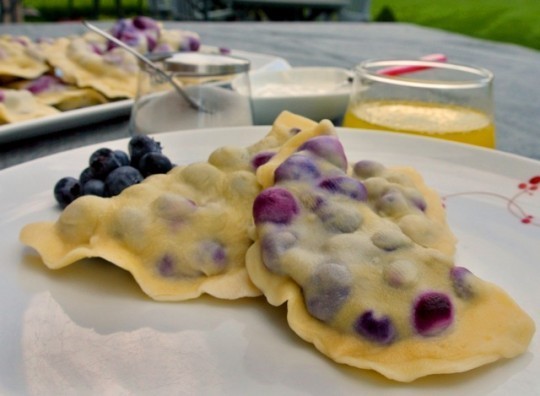
Summer’s best blueberry pierogi. Photo by Emilia Juocys
Emilia Juocys has been my assistant for several years, first from Chicago now from her home town in Michigan. She has recently, at the age of 35, made a major transition in her life. Major transitions require reflection, reevaluation; curiosity and fear about the future are also inevitable consequences. When you are a cook you turn to food for some of the understanding and grace you need. – R
By Emilia Juocys
Summer is nearly over, and the fall is closing in, and the bounty of the summer is entering our kitchen in droves. I devour the sweet summer corn and beautiful heirloom tomatoes, but for me summer would not be summer unless I had a specific summer treat. I’m also stuck in a great period of reflection, wondering where I will end up next in my life’s adventures. What I have learned so far is that there are some attributes in you that never leave. They may hide, but they come back. My love of food and sharing it with others has not disappeared—in fact it has grown stronger. This past week I stood in my parents’ kitchen preparing lunch for my 99-year-old dziadzia (grandfather) and found myself musing over my summers I had with him, my babcia (grandmother), and my sister.
As small girls growing up in a Polish household, my sister and I would eagerly wait for Babcia to make blueberry pierogi. We would wait for the blueberries to arrive at the house and we both knew it was time. A few ingredients would pop out on the table and then work to assemble them began. Oh, and the rules about who could do what.
Babcia was the only person allowed to make the dough when we were younger. She had her own measuring system of nonsensical cups, but I knew that most of the measurement was done by feel. We were allowed to gather the flour in the middle of the table, add the salt, crack the eggs into the well, and slowly add water as she began to mix my hand. Babcia would knead the dough and my sister and I would stand in awe. One of the things I miss most about her was her hands. They were worker’s hands that had lived a full life of cooking, cleaning, scrubbing walls, yard work, and sewing. When she was done kneading the dough, it had to rest beneath a moist towel. My sister and I always wanted to roll out the dough, but we could not. Babcia wanted good-looking pierogi, which meant that little girls can’t do that, although we both had our own rolling pins and kid dough to play with and practice. The only job that my sister and I were permitted to do was to cut the circles out of the dough and hand them to Babcia as she filled them.
Blueberry pierogi were our summer treats. When you are six years old and it is 95° and humid outside, all you could dream about was a cold blueberry pierogi to hold in your hand and eat as you ran around outside. Who knew the number of times I watched her make various types of pierogi over the years. That each time I learned something that was then squirreled away in my head for use later in my life. That what I learned from her is part of my family and my heritage.
Blueberry Pierogi
Traditionally my family serves their blueberry pierogi only after they are boiled and are garnished with sour cream, hot butter, and sugar. Enjoy!
2 cups all-purpose flour
2 eggs, room temperature
Pinch of salt
1 cup water (nearly)
2 tablespoons unsalted butter, room temperature (our family used butter, others use lard or cream cheese)
3 cups fresh blueberries
Flour for dusting
Using a 5-quart standing mixer with a dough hook, add the flour, eggs, salt, and some of the water to the bowl. Mix for 1 minute on medium speed until the dough begins to come together. Then add the butter. If the dough is still dry, add more water; if it is too wet, add a bit more flour. Increase the speed to high for 3 minutes. The dough should now be formed; it should not be sticky to the touch.
Rest the dough for 30 to 45 minutes, covered with a moist towel or plastic wrap. You can also wrap the dough and refrigerate it until the next day; just remember to bring the dough to room temperature before you use it.
Place a large stockpot filled with water on the stove and bring it to a boil.
Cut the dough in half. On a dusted countertop, begin to roll out your pierogi dough. Roll it fairly thin, to about 1/8″ thick, and cut circles out with a 4″ round cutter. Be sure to keep the circles close together to get the most yield out of the dough. Babcia would never reuse the dough (poor form). Repeat with the other half of the dough.
Hold the circle in your hand and fill it with as many blueberries as the dough can comfortably hold. Then cup the pierog (singular) like a taco and begin to pinch the edges to seal. Continue until you have them all filled.
To cook the pierogi, carefully drop them one at a time into the boiling water (you can probably cook 4 to 6 at a time). Cook for 2 minutes per side. Once they are done shock them in an ice bath. Drain and set aside.
You can either enjoy the goodness now or you can refrigerate them. They last about 5 days, but they are delicious, quick portable snacks.
Serve the pierogi with sugar, hot butter, and sour cream. Or just eat them as they are.
Yield: 20 pierogi
If you liked this post, read:
My recent post: the Le Creuset Cast Iron Pizza.
Emilia’s past posts on holiday cookies and biscotti.
An interesting look at the past and the future of pierogi.
History of the dumpling.
© 2013 Michael Ruhlman. Photo © 2013 Donna Turner Ruhlman. All rights reserved.
Michael Ruhlman's Blog
- Michael Ruhlman's profile
- 354 followers




